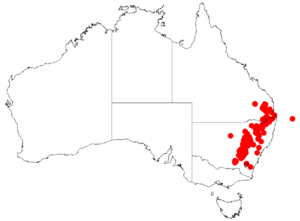Northern silver wattle facts for kids
Quick facts for kids Northern silver wattle |
|
|---|---|
| Scientific classification | |
| Genus: |
Acacia
|
| Species: |
leucoclada
|
 |
|
| Occurrence data from AVH | |
The Acacia leucoclada, commonly called the northern silver wattle, is a type of wattle tree. It is found naturally in eastern Australia.
What the Northern Silver Wattle Looks Like
This tree usually grows to be about 2.5 to 20 metres (8 to 66 ft) tall. It has smooth grey bark that gets rougher and cracked as the tree gets older. Its branches have ridges and can be angled or rounded.
When the leaves are young, their tips are a shiny silver or white color and are covered in many tiny hairs. The leaves themselves are silvery-green and can feel like paper or leather. They grow along a main stem called a rachis, which is about 2 to 9.5 cm (0.79 to 3.74 in) long. From this main stem, smaller leaf branches, called pinnae, grow out in 5 to 18 pairs. Each of these smaller branches is about 1.5 to 5.5 cm (0.59 to 2.17 in) long.
On each pinna, there are 11 to 45 pairs of even smaller leaflets called pinnules. These pinnules are narrow and shaped like a spear, measuring 1 to 6 mm (0.039 to 0.236 in) long. Each one has a single vein.
The Northern Silver Wattle blooms between July and October. It produces simple flower clusters, called inflorescences, which grow from the leaf joints or at the ends of branches. These clusters are supported by hairy stalks that are 1 to 7 mm (0.039 to 0.276 in) long. The flower-heads are round, like small balls, and are about 4 to 7 mm (0.16 to 0.28 in) across. Each one contains 20 to 26 yellow to bright yellow flowers.
After the flowers bloom, seed pods form. These pods are usually straight or slightly curved, and sometimes a bit twisted. They are thin and leathery, mostly flat, and often have slight pinches between where the seeds are. The pods are 3 to 12 cm (1.2 to 4.7 in) long and 4.5 to 12 mm (0.18 to 0.47 in) wide. They often have a fine, white powdery coating on them.
How it Got its Name
The Acacia leucoclada was first officially described in 1966 by a scientist named Mary Tindale.
The second part of its scientific name, leucoclada, comes from two ancient Greek words. Leucos means "white," and clados means "shoot" or "sprout." When combined, leucocladus describes the plant as having white shoots. This perfectly matches the silvery-white tips of its young leaves!
Where the Northern Silver Wattle Grows
You can find the Acacia leucoclada growing in many parts of eastern Australia. Its range stretches from south-eastern Queensland down into New South Wales. In New South Wales, it grows along the north coast, in the tablelands (high flat areas), on the western slopes of the Great Dividing Range, along the central coast, in the Hunter River valley, and in the Pilliga scrub regions.
It is mostly found as far south as Wagga. This wattle often grows in sclerophyll woodland communities. These are types of forests where the plants have hard, tough leaves to help them survive dry conditions. The Northern Silver Wattle can grow in many different kinds of places and soil types within these areas.

